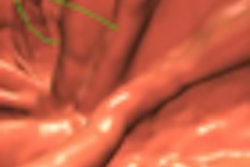Full-field digital mammography (FFDM) with computer-aided detection (CAD) found more cancers than analog mammography in a large screening population, according to a study conducted by Dutch researchers.
Nico Karssemeijer, Ph.D., and colleagues at the National Expert and Training Centre for Breast Cancer Screening in Nijmegen, Netherlands, compared the performance of FFDM plus CAD to film-screen mammography for initial and subsequent screening exams. Their findings were published in the July 31 online issue of Radiology.
At the Preventicon screening center in Utrecht, two of seven conventional mammography devices were replaced with FFDM units. A total of 367,600 screening exams were performed, with 56,518 of those being digital. In the digital group, a total of 1,239 women were recalled, and in the analog group, 4,071 were recalled. Cancer was detected in 1,927 women (317 with digital).
Screening was conducted at two-year intervals. Women received FFDM or film-screen mammograms depending on the availability of the units at the center, but women who had already had previous digital exams were always offered digital. Analog images were acquired with two types of systems: GE Healthcare's Senographe 600T and Senographe 800T (Chalfont St. Giles, U.K.). FFDM images were taken with a Selenia system (Hologic, Bedford, MA).
FFDM exams were interpreted using soft-copy reading plus CAD; the same team of radiologists also read the film-screen images.
Karssemeijer's team found that in initial screening exams, the detection rate was 0.77% with digital mammography and 0.62% with analog. In subsequent screening exams, the gap closed, with detection rates of 0.54% and 0.49%, respectively.
Analog detection of ductal carcinoma in situ was 0.12% in initial screenings and 0.08% in subsequent screens. With digital mammography, detection of ductal carcinoma in situ was 0.22% and 0.12%, respectively.
"Our results suggest that improvement of detection with [digital mammography] may be more substantial at initial screenings, which include the youngest women in the screening population," Karssemeijer and colleagues wrote.
The researchers noted that the study's screening approach was different from the practice in the U.S. and Canada, with a longer screening interval, double-read studies, and lower recall rates. But these differences don't negate the findings, they wrote, because they relate to a comparison of cancer detection by using the two techniques rather than to absolute values of performance indicators.
"FFDM with CAD demonstrates advantages for screening younger women and better detection of calcifications associated with breast cancer," the team concluded.
Related Reading
FFDM equals analog mammography in hard-copy reading, May 7, 2009
CAD boosts FFDM performance, March 4, 2009
FFDM performs well versus analog for screening, studies show, January 6, 2009
Digital mammograms take longer to read, study suggests, January 6, 2009
DMIST: Women under 50 with dense breasts benefit from FFDM, January 29, 2008
Copyright © 2009 AuntMinnie.com


















